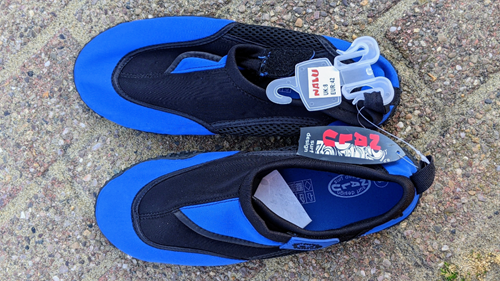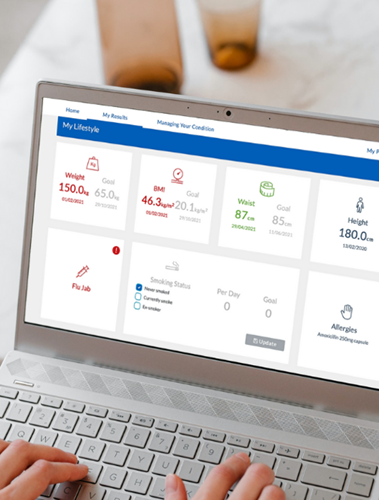Pebbles on the seashore
Looking after your feet when you have diabetes. On and off the beach...
If there is one thing I simply cannot do, it is to walk barefoot on a stony beach. It’s a standing joke in my family that I have incredibly sensitive feet.
I watch holidaymakers pacing around a beach or walking down the promenade in bare feet and wonder how on earth they can do that. I certainly couldn’t.
This year I bought some beach shoes for wearing on the beach which really work, enabling me to go for a paddle on a stony beach in relative comfort.

I once bashed my naked little toe on the leg of a sofa... 'ouch ouch, that really hurt'. You may well have had that experience yourself.
I've since made a golden rule for myself… 'never walk around the house in bare feet'.
Even when nature calls in the middle of the night, I never go to the bathroom without my slippers on… as our most often worn footwear, good condition slippers are one of life’s essentials.
Recently, my phone rang with an 'unknown number'… you have two choices... ‘answer’ or ‘decline’. Agreed, many times they are hoax calls, but would you want to miss that occasional one that is genuine and important?
I accepted the call... 'hello Mr. Churchill, this is the doctor's surgery'.
Methinks…‘here comes trouble’.
'Mr. Churchill I'd like to schedule your annual diabetes foot check'.
I breathe a sigh of relief it wasn't something more sinister, and swiftly booked a date in the diary.
As the date drew closer, I became mindful that it's rare for someone else to ever take even a glance at your bare feet... it’s hardly the sort of thing you’d ever ask even your closest friend.
As you grow older, even trimming your toenails can become quite a challenge yet is key for good foot care. Know Diabetes has some really helpful videos explaining how to keep your feet healthy.
You can watch the rest of the foot care videos here.
We all look at our faces in the mirror every morning, and I also look at my feet, checking for any changes in foot shape, skin appearance and nail appearance.
Because if you have diabetes and notice any changes in one or both of your feet, you can tell your health professional and get this sorted quickly.
Comfortable, well-fitting, good quality socks are more than just a fashion statement, they have a vital job to do and like your slippers, are busy all day long.
The examination day arrives… I check-in at the surgery and wait for my turn staring blankly sitting in the waiting room chair like a tennis player by the umpire’s chair at the change of ends.
The consultation room door opens, ‘Mr. Churchill please’… up I jump, and the examination begins.
I kick off my shoes and socks… no toes poking through… the nurse initially checks in-between the toes for any signs of infection, feels for a strong pulse all around the soles of my feet and examines the condition of my toenails for anything that might look sinister.
Though not essential at every instance, sometimes your clinician might be able to listen to the sound of blood flow with a special piece of equipment known as a ‘hand-held Doppler’.
Then out comes the mono filament... a device used to check if I can feel even the mildest of sensations. ‘Can you feel this?’ ‘yes’, ‘and this ‘yes’ and so on.
Any loss of that ‘protective sensation’ is a major factor in diabetes foot care. Find out more by clicking the button below or try out the Know Diabetes foot quiz.
At the end of the examination, you are awarded a ‘Risk Status Classification’ depending on the condition of your feet.
- Low
- Medium
- High
Your health care professional will talk to you about this at the end of the appointment and give you appropriate advice.
Then as a finale, you stand on the scales for your weight to be recorded, then your height measured and finally, your blood pressure taken. All of these measurements are a vital part of your medical record.
It's important that you know your numbers, though we are all prone to forgetfulness. Having a handy point of reference really helps - the Know Diabetes (KD) Service is a handy reference point for all of your key medical results.
Your weight and height are used to calculate your Body Mass Index (BMI). The Know Diabetes website helpfully records your latest measurements and calculates your BMI, with red/amber/green colour codes to highlight areas where there might be room for improvement.

Image: Know Diabetes health dashboard.
Following your appointment, allow for three or four working days, and then ‘hey presto’, check your ‘Patient Record Access’ section on your Know Diabetes account and there you will find your most recent results.
Similarly, other blood test results like your latest Cholesterol and HbA1C will be found in this section.
Having key information in one digital place is absolutely fabulous and essential to help us live with our diabetes more confidently.
These vital measurements and results are essential to managing Diabetes just like those pebbles on the seashore … each to be handled with extreme interest and care.




